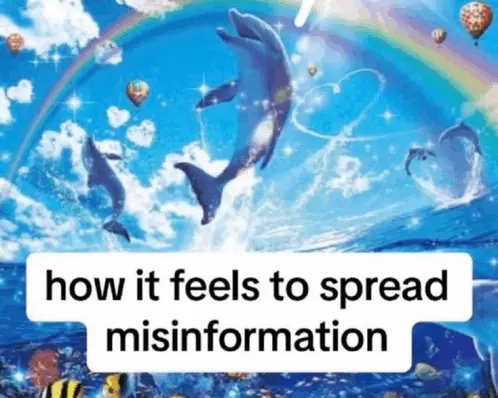As a viral meme spreader, I revel in the thrill of watching misinformation about dolphins spread like wildfire, even if it means sowing chaos online. The ability to influence and manipulate online narratives through the power of memes is both exhilarating and concerning.
In this article, I will explore the psychology behind the “How It Feels to Spread Misinformation Meme Dolphin” phenomenon, the impact of false information on social media, and the ethical considerations of meme culture.
Navigating the Viral Nature of Memes
Memes have become an integral part of modern online communication, captivating audiences with their ability to spread rapidly and capture attention. The psychology behind sharing memes is complex, often driven by a desire for social validation, entertainment, or a sense of belonging to a particular online community.
The Psychology Behind Sharing Memes
The allure of memes lies in their ability to tap into our innate human need for social connection and belonging. When we share a meme, we’re not just passing along a funny or thought-provoking image; we’re also signaling our alignment with a particular online subculture or the values it represents.
This sense of shared identity and community can be a powerful motivator for meme sharing, especially when it comes to the meme culture and the viral misinformation that can spread through these digital artifacts.
Unintended Consequences of Meme Propagation
However, the viral nature of memes can also lead to unintended consequences, such as the rapid spread of online deception and false narratives. When meme culture intersects with social media manipulation and digital propaganda, the result can be the proliferation of internet hoaxes and the erosion of trust in online information.
The how it feels to spread misinformation meme dolphin phenomenon is a prime example of this, where the captivating imagery of dolphins is used to lure unsuspecting social media users into engaging with and sharing viral misinformation. This tactic highlights the need for increased digital literacy and fact-checking efforts to combat the spread of false narratives in the digital age.
The “How It Feels to Spread Misinformation Meme Dolphin” Phenomenon
The “How It Feels to Spread Misinformation Meme Dolphin” phenomenon is a prime example of the power of memes to influence online discourse. By creating and sharing memes that depict dolphins in a fantastical or misleading way, meme creators can tap into the public’s fascination with these marine creatures to spread false information.
This tactic has been used to promote a variety of conspiracy theories, hoaxes, and misinformation, with the dolphin imagery serving as a hook to capture the attention of unsuspecting social media users.
The rapid and far-reaching nature of social media platforms has played a significant role in the spread of misinformation, including the “How It Feels to Spread Misinformation Meme Dolphin” phenomenon. The amplification effect of these platforms, where content can quickly gain traction and reach a vast audience, has enabled meme creators to capitalize on the viral potential of their creations. This has led to the proliferation of false narratives, internet hoaxes, and digital propaganda that can have far-reaching consequences for individuals and society.
The ability to create and share memes that deliberately mislead or manipulate online discourse raises important ethical considerations about the balance between free speech and responsible sharing. While the freedom to express oneself creatively is a fundamental right, the potential for meme culture to contribute to the spread of online deception and viral misinformation requires a thoughtful approach to addressing these challenges.
Dissecting the Dolphin Imagery
Dolphins have long held a special place in human culture, often being associated with intelligence, playfulness, and a connection to the natural world. This symbolic and cultural significance makes them an appealing subject for meme creators looking to leverage emotional responses and generate widespread interest. By incorporating dolphin imagery into memes that spread misinformation, meme spreaders can tap into these positive associations and make their false narratives more compelling and shareable.
Symbolism and Cultural Significance
The dolphin has been revered in many cultures as a symbol of wisdom, joy, and environmental stewardship. These positive connotations make the dolphin imagery an effective tool for meme culture and social media manipulation, as the visual cue can draw in unsuspecting users and make the viral misinformation more palatable. By exploiting the public’s fondness for these marine creatures, meme creators can online deception and spread internet hoaxes and digital propaganda more effectively.
Social Media’s Role in Misinformation Spread
The rapid and far-reaching nature of social media platforms has played a significant role in the spread of misinformation, including the “How It Feels to Spread Misinformation Meme Dolphin” phenomenon. The amplification effect of these platforms, where content can quickly gain traction and reach a vast audience, has enabled meme creators to capitalize on the viral potential of their creations.
The Amplification Effect of Online Platforms
Social media’s ability to rapidly disseminate content has been a double-edged sword when it comes to the spread of viral misinformation. Memes and other forms of online deception can gain momentum and reach far beyond their original source, fueling the spread of false narratives and internet hoaxes. This digital propaganda can have a significant impact on public perception and discourse, making it a crucial issue to address.
Fact-Checking and Digital Literacy
However, the same social media platforms that enable the rapid spread of misinformation also offer opportunities for fact-checking and the development of digital literacy skills. By empowering users to critically evaluate the content they encounter online and identify social media manipulation, we can work to combat the how it feels to spread misinformation meme dolphin phenomenon and other instances of false information propagating through the digital landscape.
Ethical Considerations of Meme Culture
The rise of meme culture has raised important ethical considerations, particularly when it comes to the spread of misinformation.
While free speech is a fundamental right, the ability to create and share memes that deliberately mislead or manipulate online discourse raises questions about the line between creative expression and digital irresponsibility. As a passionate meme enthusiast, I’ve grappled with these complex issues, seeking to balance my love of meme culture with the need for responsible and truthful online communication.
Balancing Free Speech and Responsible Sharing
When it comes to the “How It Feels to Spread Misinformation Meme Dolphin” phenomenon, I can understand the allure of creating and sharing captivating content that taps into the public’s fascination with these marine creatures.
However, the reality is that the rapid spread of false information, whether intentional or not, can have far-reaching consequences. Viral misinformation, social media manipulation, and the proliferation of internet hoaxes and digital propaganda have the potential to erode trust, sow division, and undermine the integrity of online discourse.
As such, it’s crucial that we carefully consider the ethical implications of meme culture and strive to strike a balance between the right to free speech and the responsibility to share content responsibly.
This may involve self-reflection on the motivations behind meme creation, a deeper understanding of the potential impact of our online actions, and a commitment to fact-checking and digital literacy.
By taking a more thoughtful and nuanced approach to meme culture, we can work towards preserving the creativity and vibrancy of this medium while mitigating the risks of viral misinformation and deception.
FAQ
What is the “How It Feels to Spread Misinformation Meme Dolphin” phenomenon?
The “How It Feels to Spread Misinformation Meme Dolphin” phenomenon refers to the viral spread of memes that depict dolphins in a fantastical or misleading way in order to promote false information or conspiracy theories. These memes tap into the public’s fascination with dolphins and use their symbolic and cultural significance to capture attention and make the misinformation more compelling and shareable.
What is the psychology behind sharing memes?
The psychology behind sharing memes is complex, often driven by a desire for social validation, entertainment, or a sense of belonging to a particular online community. Memes have the ability to spread rapidly and capture attention, which can lead to unintended consequences, such as the rapid spread of misinformation or the reinforcement of harmful stereotypes.
How do social media platforms contribute to the spread of misinformation?
Social media platforms play a significant role in the spread of misinformation, including the “How It Feels to Spread Misinformation Meme Dolphin” phenomenon.
The amplification effect of these platforms, where content can quickly gain traction and reach a vast audience, has enabled meme creators to capitalize on the viral potential of their creations.
However, these same platforms also offer opportunities for fact-checking and the development of digital literacy skills, which are essential in combating the spread of false information online.
What are the ethical considerations of meme culture?
The rise of meme culture has raised important ethical considerations, particularly when it comes to the spread of misinformation.
While free speech is a fundamental right, the ability to create and share memes that deliberately mislead or manipulate online discourse raises questions about the line between creative expression and digital irresponsibility.
Striking a balance between these competing priorities is crucial in addressing the challenges posed by the “How It Feels to Spread Misinformation Meme Dolphin” phenomenon and other instances of viral deception online.
How do the symbolic and cultural significance of dolphins contribute to the spread of misinformation?
Dolphins have long held a special place in human culture, often being associated with intelligence, playfulness, and a connection to the natural world.
This symbolic and cultural significance makes them an appealing subject for meme creators looking to leverage emotional responses and generate widespread interest.
By incorporating dolphin imagery into memes that spread misinformation, meme spreaders can tap into these positive associations and make their false narratives more compelling and shareable.







